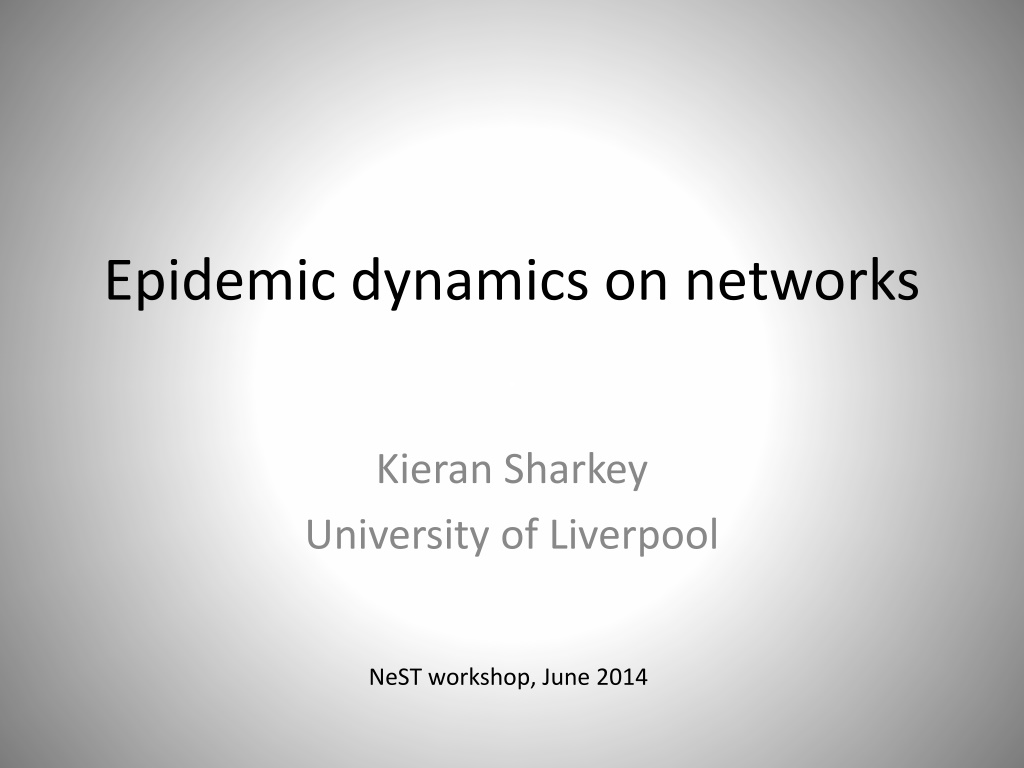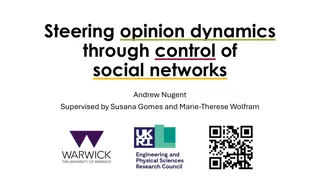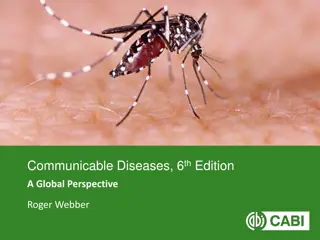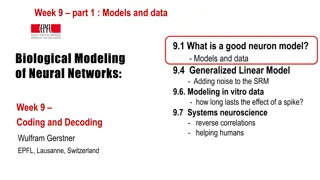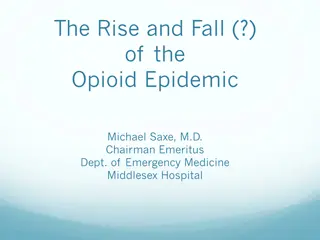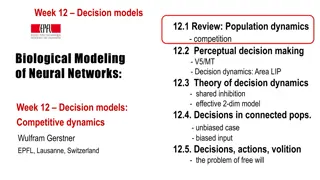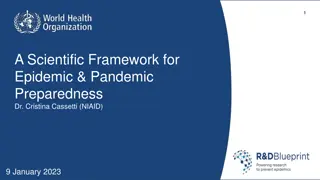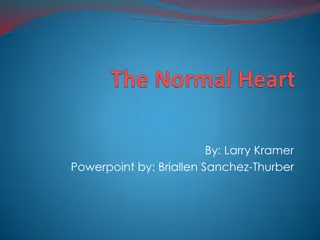Epidemic Dynamics on Networks: Insights and Models
Explore the dynamics of epidemics on networks through moment-closure and message-passing representations. Discover modeling aquatic infectious diseases and the SIR compartmental model. Understand contact and transmission networks, along with the probability calculations for susceptible nodes. Dive into the concepts of moment closure and the BBGKY hierarchy in epidemic modeling studies by Sharkey.
Download Presentation

Please find below an Image/Link to download the presentation.
The content on the website is provided AS IS for your information and personal use only. It may not be sold, licensed, or shared on other websites without obtaining consent from the author. Download presentation by click this link. If you encounter any issues during the download, it is possible that the publisher has removed the file from their server.
E N D
Presentation Transcript
Epidemic dynamics on networks Kieran Sharkey University of Liverpool NeST workshop, June 2014
Overview Introduction to epidemics on networks Description of moment-closure representation Description of Message-passing representation Comparison of methods
Some example network slides removed here due to potential data confidentiality issues.
Route 2: Water flow (down stream) Modelling aquatic infectious disease Jonkers et al. (2010) Epidemics
Route 2: Water flow (down stream) Jonkers et al. (2010) Epidemics
States of individual nodes could be: Susceptible Infectious Removed
The SIR compartmental model States of individual nodes could be: Susceptible Infectious Removed Infection S I All processes Poisson Removal R
Contact Networks 1 2 3 4 0 0 0 0 0 0 1 0 0 1 0 0 1 1 0 0 1 = 2 G 2 3 3 4 1 4
Transmission Networks 1 2 3 4 0 0 0 0 0 0 T23 0 0 T32 0 0 T41T42 0 0 T23 1 = 2 T T32 2 3 3 4 T42 1 T41 4
Moment closure & BBGKY hierarchy iS Probability that node i is Susceptible N j i ??? = j = S T S I i ij i j 1 N = I T S I g I i ij i j i = 1 j Sharkey, K.J. (2008) J. Math Biol., Sharkey, K.J. (2011) Theor. Popul. Biol.
Moment closure & BBGKY hierarchy N = j = S T S I i ij i j 1 N = I T S I g I i ij i j i = 1 j = S I T S S I T I S I T S I g S I i j jk i j k ik k i j ij i j i j k i k j i j i j i j i j k k Sharkey, K.J. (2008) J. Math Biol., Sharkey, K.J. (2011) Theor. Popul. Biol.
Moment closure & BBGKY hierarchy N = j = S T S I i ij i j 1 N = I T S I g I i ij i j i = 1 j = S I T S S I T I S I T S I g S I i j jk i j k ik k i j ij i j i j k i k j k S k = S T I S S S S I i j ik k i j i j k j i Hierarchy provably exact at all orders To close at second order can assume: A B B C iA C i j j k A B C k i j k B j B j Sharkey, K.J. (2008) J. Math Biol., Sharkey, K.J. (2011) Theor. Popul. Biol.
Random Network of 100 nodes Sharkey, K.J. (2008) J. Math Biol., Sharkey, K.J. (2011) Theor. Popul. Biol.
Random Network of 100 nodes Sharkey, K.J. (2008) J. Math Biol., Sharkey, K.J. (2011) Theor. Popul. Biol.
Random K-Regular Network Sharkey, K.J. (2008) J. Math Biol., Sharkey, K.J. (2011) Theor. Popul. Biol.
Locally connected Network Sharkey, K.J. (2008) J. Math Biol., Sharkey, K.J. (2011) Theor. Popul. Biol.
Example: Tree graph For any tree, these equations are exact Sharkey, Kiss, Wilkinson, Simon. B. Math. Biol . (2013)
Extensions to Networks with Clustering 1 2 ?1?2?3 ?3?4 ?3 ?1?2?3?4 = 3 4 2 1 ?1?2?3 ?3?4?5 ?3 ?1?2?3?4?5 = 3 5 4 Kiss, Morris, Selley, Simon, Wilkinson (2013) arXiv preprint arXiv:1307.7737
Application to SIS dynamics N = = + S T S I g I i ij i j i 1 j N = I T S I g I i ij i j i = 1 j = + S I T S S I T I S I T S I g S I g I I i j jk i j k ik k i j ij i j i j i j k i k j = + + S S T I S S S S I g S I g I S i j ik k i j i j k i j i j k j k i A B B C i j j k A B C Closure: i j k B j Nagy, Simon Cent. Eur. J. Math. 11(4) (2013)
Moment-closure model Exact on tree networks Can be extended to exact models on clustered networks Can be extended to other dynamics (e.g. SIS) Problem: Limited to Poisson processes
Karrer and Newman Message-Passing Karrer B and Newman MEJ, Phys Rev E 84, 036106 (2010)
Karrer and Newman Message-Passing j i Cavity state Fundamental quantity: ?? ?? : Probability that i has not received an infectious contact from j when i is in the cavity state. Karrer B and Newman MEJ, Phys Rev E 84, 036106 (2010)
Karrer and Newman Message-Passing j i Cavity state Fundamental quantity: ?? ?? : Probability that i has not received an infectious contact from j when i is in the cavity state. ?= ? ?? ?? ?? is the probability that j has not received an ? ? ? infectious contact by time t from any of its neighbours when i and j are in the cavity state. Karrer B and Newman MEJ, Phys Rev E 84, 036106 (2010)
Karrer and Newman Message Passing Define:???? : Probability that ? infects ? within time ? of being infected is: 0 ? ??? ?? = ??? ? ????? ?? (Combination of infection process ???? and removal ??? ). 1 if j initially susceptible ???? ?? = ???? 1 ??? ?? ? 0 ????? 1 ?? ? ?? ? ?? Message passing equation: ?? ?(?) = 1 0 ? ?? ?? ? ??? ?? = ?? ?? = 1 ?? ?? ?? = ? ? 1 ?? 0 ? ?? Fundamental quantity: ?? ?? : Probability that i has not received an infectious contact from j when i is in the cavity state. ?= ? ?? ?? ?? is the probability that j has not received an ? ? ? infectious contact by time t from any of its neighbours when i and j are in the cavity state. Karrer B and Newman MEJ, Phys Rev E 84, 036106 (2010)
Karrer and Newman Message-Passing 1) Applies to arbitrary transmission and removal processes 2) Not obvious to see how to extend it to other scenarios including generating exact models with clustering and dynamics such as SIS Useful to relate the two formalisms to each other Karrer B and Newman MEJ, Phys Rev E 84, 036106 (2010)
Relationship to moment-closure equations ? ?? ? ?? ?? ?= 1 ???? 1 ?? ? 0 When the contact processes are Poisson, we have: ???? = ???? ???? ??? ?? so: ???? = ???? ???? ? ? ??? ?? ?? ?? ?? ? ??? ? ????1 ?? ? = ????? ?? ?? ? ?? 0 ?? ?? ? ???? = ???? ? ? ?? ?? ? ?? ?? ???? = ?? ? 1 ?? ? ???? + ???? 1 ?? ? 0 Wilkinson RR and Sharkey KJ, Phys Rev E 89, 022808 9 (2014)
Relationship to moment-closure equations When the removal processes are also Poisson: ??? = ??? ??? = S I T S S I T I S I T S I g S I i j jk i j k ik k i j ij i j i j k i k j ???? ???? ?? = S I T S S I T I S I T S I g S I ?????? = i j jk i j k ik k i j ij i j i j k i k j Wilkinson RR and Sharkey KJ, Phys Rev E 89, 022808 9 (2014)
Relationship to moment-closure equations When the removal process is fixed, Let ??? = ? ? ?? Wilkinson RR and Sharkey KJ, Phys Rev E 89, 022808 9 (2014)
SIR with Delay Wilkinson RR and Sharkey KJ, Phys Rev E 89, 022808 9 (2014)
SIR with Delay Wilkinson RR and Sharkey KJ, Phys Rev E 89, 022808 9 (2014)
Summary part 1 Pair-based moment closure: Exact correspondence with stochastic simulation for tree networks. Extensions to: Exact models in networks with clustering Non-SIR dynamics (eg SIS). Limited to Poisson processes Message passing: Exact on trees for arbitrary transmission and removal processes Not clear how to extend to models with clustering or other dynamics
Summary part 2 Linking the models enabled: Extension of the pair-based moment-closure models to include arbitrary removal processes. Proof that the pair-based SIR models provide a rigorous lower bound on the expected Susceptible time series. Extension of message passing models to include: a)Heterogeneous initial conditions b)Heterogeneous transmission and removal processes
Acknowledgements Robert Wilkinson (University of Liverpool, UK) Istvan Kiss (University of Sussex, UK) Peter Simon (Eotvos Lorand University, Hungary)
